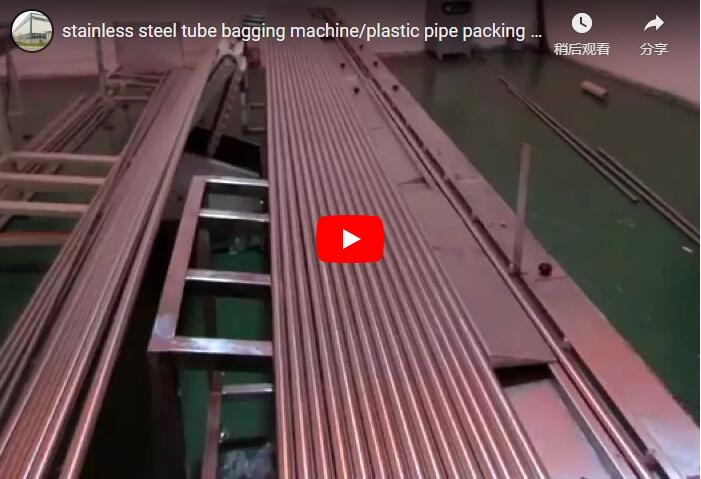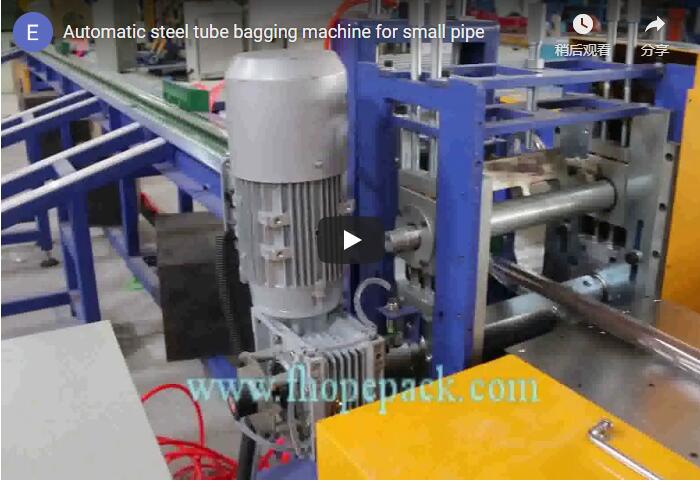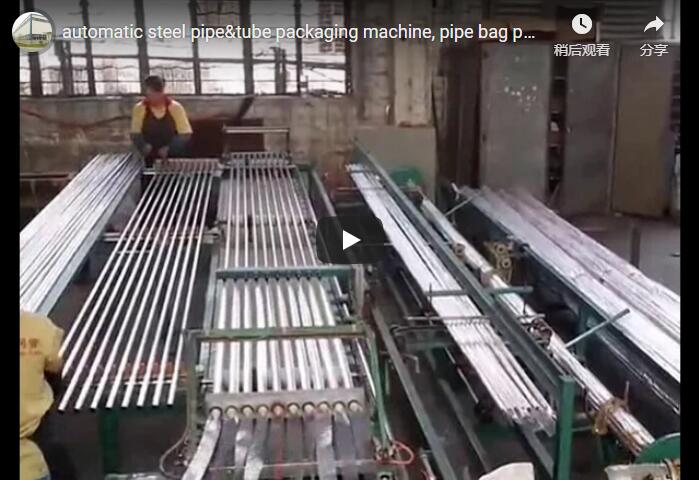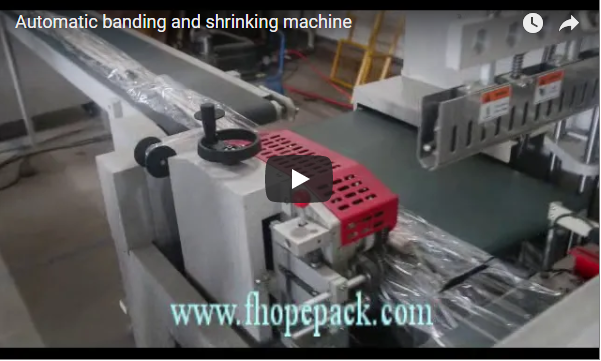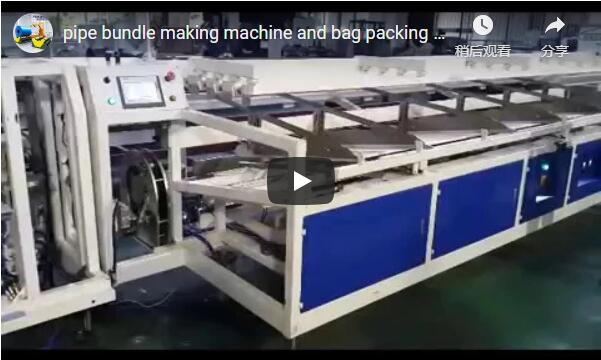Revolutionizing Pipe Production: A Technical Deep Dive into Online Pipe Strapping Lines
In modern manufacturing, particularly in pipe extrusion processes, efficiency and automation are paramount. Manual handling downstream from the extruder often creates bottlenecks, increases labor costs, and introduces inconsistencies. The solution? An integrated Online Pipe Strapping Line, a sophisticated system designed to automate the entire post-extrusion process from pipe transport to final bundling. This article delves into the technical intricacies, design considerations, operational benefits, and real-world application of these essential automated systems.
1. The Challenge: Overcoming Post-Extrusion Inefficiencies
Traditionally, extruded pipes require significant manual intervention for cutting, counting, bundling, and strapping. This process is not only labor-intensive but also prone to:
- Inconsistent Bundle Quality: Manual strapping can lead to variations in tension and bundle shape.
- Reduced Throughput: Manual handling limits the overall speed of the production line.
- Potential for Product Damage: Handling long sections of pipe manually increases the risk of scratches or deformation.
- Workplace Safety Concerns: Repetitive lifting and handling pose ergonomic risks.
An online pipe strapping line directly addresses these challenges by seamlessly integrating downstream handling with the extrusion process.
2. Core Functionality: Anatomy of an Automated Workflow
These automated pipe packaging systems execute a precise sequence of operations:
2.1. Automated Infeed Conveying
Directly receives pipes from the extruder's haul-off unit or cooling tank. Typically utilizes synchronized belt or roller conveyors designed to handle specific pipe profiles and materials (e.g., PVC, HDPE, PP-R) without causing damage. Speed synchronization with the extruder is critical.
2.2. Precision Cutting
Once the desired pipe length is reached (often detected by laser or encoder), an integrated cutting unit activates. Common technologies include:
- Planetary Saws: For clean, burr-free cuts on various plastic types.
- Guillotine Cutters: Suitable for specific materials and profiles.
The cutting process is automated and precisely timed to ensure consistent lengths (+/- tolerance defined by specification, often within millimeters).
2.3. Accurate Counting
As cut pipes proceed, sensors (typically optical or laser-based) meticulously count each piece. This count triggers the subsequent bundling and strapping operations once the pre-set number per bundle is reached.
2.4. Accumulation and Bundling
Counted pipes are transferred to an accumulation or bundling station. This often involves mechanisms that arrange the pipes into a desired configuration (e.g., square, rectangular, hexagonal) using pneumatic or servo-driven guides.
2.5. Secure Strapping
An automatic strapping head applies straps (typically PP or PET) around the formed bundle. Key parameters controlled automatically include:
- Strap Tension: Ensures bundle integrity without damaging the pipes.
- Sealing Method: Friction-weld or heat seal for durable strap joints.
- Number of Straps: Programmable based on bundle length and stability requirements.
2.6. Automated Collection and Discharge
Completed bundles are ejected onto a collection system. A common design involves a tilting collection cart or table that flips over or lowers to receive the bundle, often buffering it before final removal by forklift or AGV. This minimizes manual handling and allows continuous operation.
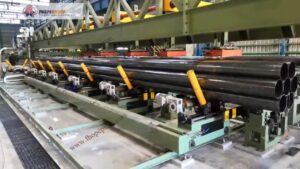
3. Deep Dive: Design, Structure, and Key Components
The reliability and efficiency of an online pipe strapping line hinge on its engineering and component selection:
- Structural Frame: Typically constructed from heavy-duty welded steel profiles (e.g., carbon steel with powder coating or stainless steel for specific environments) to ensure rigidity and vibration damping.
- Conveyor System: Must match pipe characteristics. Rollers may be rubber-coated or specially profiled. Belt conveyors offer continuous support. Variable Speed Drives (VSDs) are standard for synchronization.
- Cutting Unit: Precision is key. Servo-driven blades or advanced planetary saws offer high accuracy and clean cuts, minimizing secondary finishing needs. Dust extraction systems are often integrated.
- Counting Sensors: High-reliability photoelectric or laser sensors ensure accurate counts even at high line speeds. Logic controllers prevent miscounts during pipe transfer.
- Strapping Head: A critical component. Renowned brands (e.g., Signode, Mosca, Fromm - though specific machine integrators use various heads) are often preferred for reliability and low maintenance. Features include automatic strap feeding, tensioning, sealing, and cutting.
- Collection System: Designed for robustness. Pneumatic or hydraulic actuation is common for tilting mechanisms. Sensors confirm bundle presence and successful ejection.
- Control System: Typically managed by a Programmable Logic Controller (PLC) (e.g., Siemens, Allen-Bradley, Mitsubishi) integrated with a Human-Machine Interface (HMI) – usually a touchscreen panel. The HMI allows operators to set parameters (pipe length, count per bundle, strap tension, bundle configuration), monitor status, and troubleshoot errors.
4. Technical Specifications & Performance Data
While varying by manufacturer and application, typical performance parameters include:
- Pipe Diameter Range: 16mm - 630mm (System dependent)
- Pipe Length Range: 1m - 12m (Configurable)
- Line Speed Compatibility: Up to 30 m/min (Matched to extruder output)
- Strapping Cycle Time: 10 - 30 seconds per bundle (Depending on bundle size and number of straps)
- Bundle Configurations: Square, Rectangular, Hexagonal (Often programmable via HMI)
- Strap Compatibility: PP (Polypropylene) or PET (Polyester), 9mm - 19mm width
- Cutting Tolerance: +/- 1mm to 5mm (Depending on system precision)
- Power Requirements: Typically 380V/415V/480V, 3-Phase, 50/60Hz
- Control: PLC with Touchscreen HMI, optional remote diagnostics
(Note: These are representative figures; actual specifications depend on the specific model and customization.)
5. The User Experience: Integration and Operation
From an operational standpoint, well-designed online pipe strapping lines offer:
- Seamless Integration: Designed to communicate effectively with upstream (extruder, haul-off) and potentially downstream (palletizing, wrapping) equipment.
- Intuitive Operation: Modern HMIs provide graphical interfaces for easy setup ("recipe" storage for different pipe sizes/bundles), real-time monitoring, and alarm diagnostics.
- Safety Compliance: Equipped with safety guards, interlocks, emergency stops, and light curtains adhering to international safety standards (e.g., CE, OSHA).
- Maintenance Accessibility: Designed with consideration for access to key components like the strapping head and cutting unit for routine maintenance and strap coil changes.
6. Quantifiable Benefits: Driving ROI
Implementing an online pipe strapping line delivers tangible results:
- Significant Throughput Increase: Eliminates manual bottlenecks, allowing the entire production line to operate closer to its maximum potential speed.
- Drastic Reduction in Labor Costs: Frees up personnel previously dedicated to manual cutting, counting, and strapping for more value-added tasks.
- Enhanced Product Quality & Consistency: Automated processes ensure uniform pipe lengths, consistent bundle shapes, and optimal strap tension, reducing damage and improving presentation.
- Improved Workplace Safety: Removes manual lifting and repetitive strain associated with pipe handling.
- Faster Return on Investment (ROI): Achieved through labor savings, increased output, reduced waste/damage, and improved operational efficiency.
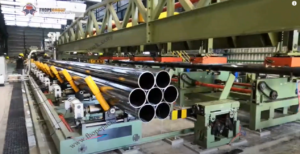
7. Considering Implementation: Factors for Success
When evaluating an online pipe strapping line, consider:
- Integration Complexity: Compatibility with existing extrusion equipment.
- Space Footprint: Ensure sufficient floor space for the entire line.
- Pipe Characteristics: Material, diameter range, length range, wall thickness.
- Required Throughput: Match capacity to production needs.
- Customization Needs: Specific bundle sizes, configurations, or handling requirements.
- Vendor Support: Training, spare parts availability, and technical service.
8. Manufacturer Spotlight: Tailored Solutions
Companies like Fhope specialize in providing these online machines for automatic pipe feeding, cutting, counting, strapping, and collection. They are recognized for offering solutions often perceived as having a favorable price-performance ratio. Key strengths include:
- Ease of Use: Designing systems with user-friendly interfaces and operation.
- High Efficiency: Engineering lines optimized for speed and reliability.
- Customization: Ability to tailor machines to specific customer requirements, pipe types (including solutions detailed in their Automatic Steel Tube Packing Line offerings), and factory layouts.
Choosing a knowledgeable manufacturer ensures the system is not just functional but perfectly aligned with unique production demands, maximizing the benefits of automation.
Conclusion: Automating for Competitive Advantage
The online pipe strapping line is more than just downstream equipment; it's a strategic investment in efficiency, quality, and safety for pipe manufacturers. By automating the critical steps between extrusion and final packaging, these systems eliminate bottlenecks, reduce operational costs, and ensure consistent product quality. As the demand for higher throughput and reduced manual intervention grows, the adoption of sophisticated, integrated automatic pipe packaging systems will continue to be a key differentiator for forward-thinking manufacturers in the competitive global market.

